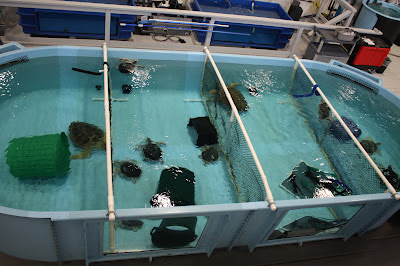Every summer,
harbor seal pups come on shore and we must learn to share the beach with them. Unfortunately for these young animals, as they learn life on their own (it only takes 4 weeks for them to be weaned and completely independent from their mother!), they tend to pick some crowded or awkward beaches to rest on. The best thing you can do for them is keep your distance and call our
stranding hotline - 617-973-5247.
![]() |
| The majority of the time, seals are just resting on the beach. This harbor seal pup picked some good rocks to rest on. They come out to rest, so don't be surprised if they look tired. |
![]() |
| The above harbor seal pup is in very good condition. He is laying on his side and has a good body weight. Unfortunately you can notice someone incredibly close to the animal. Although seals tend not to retreat from humans, our presence, including the sound of our voices, is not comforting. |
![]() |
| Above, you can see how stressful it is for a harbor seal pup to rest on this beach. These people are too close! Sometimes you can not always tell externally the extreme physiological stress the animal is experiencing. Since this seal is a pup and still naive, he hasn't figured out the effect this will have on him. It is recommended to stay at least 150 feet away from seals on the beach to limit the stress. |
Sometimes seals, like the one above, sustain wounds. Not all are life threatening though so when you call our hotline, remaining calm and using the best description of the wound is extremely helpful. We may ask for photos to assess, but you should remember not to get too close. Seals are protected by the
Marine Mammal Protection Act so it is illegal to harass them in any way (anything that will alter their natural behavior). The above photo shows a seal that was closely approached by the photographer, so he is unable to rest as he would normally do on the beach.
![]() |
| There are some signs of stress that you can look for. For example, the above gray seal is not waving at the photographer. The flipper movement is a sign of stress and is your cue to back away. Other signs of stress include shivering, vocalizing, yawning, and labored breathing. |
Seals should never be covered or have water poured on them. It is natural for them to be on the beach, and they are able to thermoregulate so you do not want to interfere with that process. Also, do not offer the animal any food. Seals are opportunistic feeders and do not eat every day or on land. Human food is also not appropriate for them.
![]() |
| Keep in mind sometimes these young pups rest in awkward places, as you
can see in the above photo where the seal is resting on the stairs. |
![]() |
| Some people get concerned about seals being on such rocky beaches as
well, but it is natural for them to rest on rocks and we are not alarmed
when we see some superficial abrasions from the rough environment. |
![]() |
| Sometimes seals do get in situations we can help with. Can you find the
seal in the top left photo? This seal was on a jetty, but as people
approached, it went further and further into the rocks. He likely could
have gotten out on his own if the area was quiet, but we were able to
help him a bit and move him to a quiet beach where he went back in the
water (Photo below). |
![]()
Another case we dealt with last week involved a seal with a fish hook in it's mouth. The pictures below tell the tale. The seal came out on a very crowded beach, but luckily some beach goers were able to rope the area off for us. This gave us time to respond with out the seal being scared back into the water.
![]() |
| Helpful beach-goers roped off the area around the injured seal. |
![]() |
| You can see the fish hook in the seal's mouth. |
![]() |
| Fish hook successfully removed |
![]() |
| Seal returns to the ocean on its own |
We were able to remove the fish hook fairly easily. We cleaned up the wound, which wasn't as severe as you would expect, and relocated the seal to a quiet beach where it could get the rest it needed to heal. Or in this case it went back in the water (photo above). This
article from the Newburyport Daily News explains how everyone, including state police and the public, came together that day to make a bad situation have a good outcome.
![]() |
| Relocating a seal is a last resort as this process is also very
stressful for an animal. So remember, always keep your distance and
share the shore with the seal pups on the beach! |
As you can see, seals are keeping us pretty busy these days. You can read past
posts here on what to do when you see a seal on the beach. But we also have some turtles still in our care.
Don't forget about the Live Webcast On Wednesday July 18th at noon to see our sea turtle patients and get an update on the rescue department activities. I hope to see you there!
~Kerry





























